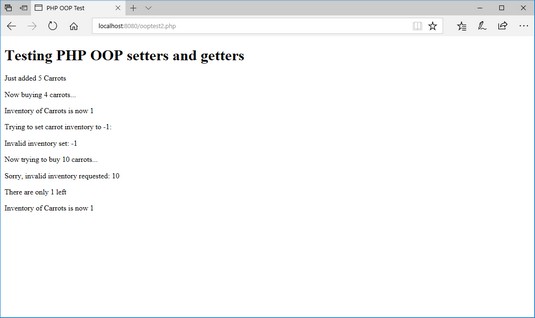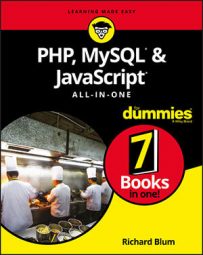You define the accessor using the special __get() method:
public function __get($name) {
return $this->$name;
}
That's all there is to it! Accessor methods aren’t overly complicated; they just return the current value of the property. To use them you just reference the property name as normal:
echo "<p>Product: $prod1->description</p>\n";PHP automatically looks for the accessor method to retrieve the property value. Follow these steps to try creating and using a class definition with mutators and accessors:
- Open your editor and type the following code:
<!DOCTYPE html> <html> <head> <title>PHP OOP Test</title> </head> <body> <h1>Testing PHP OOP setters and getters</h1> <?php class Product { private $description; private $price; private $inventory; private $onsale;public function __set($name, $value) { if ($name == "price" && $value < 0) { echo "<p>Invalid price set<p>\n"; $this->price = 0; } elseif ($name == "inventory" && $value < 0) { echo "<p>Invalid inventory set: $value</p>\n"; } else { $this->$name = $value; } }
public function __get($name) { return $this->$name; }
public function buyProduct($amount) { if ($this->inventory >= $amount) { $this->inventory -= $amount; } else { echo "<p>Sorry, invalid inventory requested: $amount</p>\n"; echo "<p>There are only $this->inventory left</p>\n"; } } }
$prod1 = new Product(); $prod1->description = "Carrots"; $prod1->price = 1.50; $prod1->inventory = 5; $prod1->onsale = false;
echo "<p>Just added $prod1->inventory $prod1->description</p>\n";
echo "<p>Now buying 4 carrots...<p>\n"; $prod1->buyProduct(4); echo "<p>Inventory of $prod1->description is now $prod1->inventory</p>\n";
echo "<p>Trying to set carrot inventory to -1:</p>\n"; $prod1->inventory = -1;
echo "<p>Now trying to buy 10 carrots...</p>\n"; $prod1->buyProduct(10); echo "<p>Inventory of $prod1->description is now $prod1->inventory</p>\n"; ?> </body> </html>
- Save the file as
ooptest2.phpin theDocumentRootfolder for your web server. - Ensure that the web server is running, and then go here to test your code.
- Close the browser window when you're done.
 The output from the
The output from the ooptest2.php program.There’s a lot going on in this example, so hang in there with me! First, the PHP code defines the Product class, using the four properties, but this time it defines them with private visibility. Following that, the mutator and accessor magic methods are defined. The mutator checks to ensure the price and inventory properties can't be set to a negative value.
After the class definition, the code creates an instance of the Product class, and experiments with the inventory values. First, it uses the buyProduct() method to purchase four carrots. That works just fine.
Next, it uses the mutator to set the inventory property for the carrot object to a negative value. The mutator code intercepts that request and prevents the inventory from being set, instead producing an error message.
Finally, the code tries to use the buyProduct() method to purchase more carrots than what's set in inventory. The added code in the buyProduct() method prevents that from happening.
Now the class definition is starting to do some useful functions for the application. But wait, there are more magic methods available for you to use!

